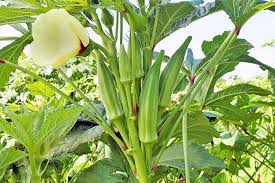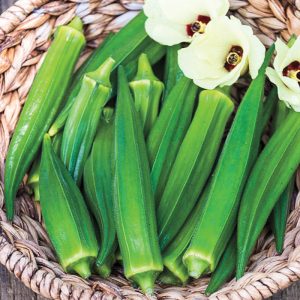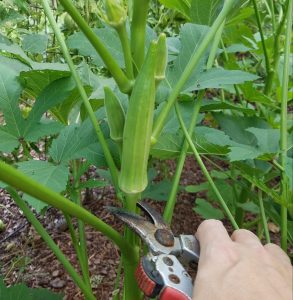Growing Okra (Bhindi) from Seed to Harvest
Okra is an annual vegetable crop. It is grown all over the world in tropical and temperate regions. The tender pods are used as a vegetable. Okra sticks (dried pieces of okra) are used when the army is in the highlands. Fresh okra has good demand in Gulf countries.
Uses:
- Tender okra is used in the preparation of various dishes. It can be fried, boiled, and eaten as a salad or with soup.
- The juice from the roots and stems of gumbo is used in jaggery and sugar industries to purify sugarcane juice.
- In Turkey, ripe okra seeds are roasted and powdered and used as a substitute for “coffee powder”.
- The pulp extracted from mature stems and pods is used in the paper industry.
- Also, this Okra has some medicinal properties. It is used for the prevention of urinary and digestive diseases. As these nuts are high in iodine, they are used for the prevention of “goiter”. In Turkey, a medicine made from the okra leaves is used to soothe burns. Its glue is used to prevent hemorrhoids.
Varieties of Okra:

Open Pollinated Verities: It’s proven that Okra Non-Hybrid(OP) verities are as productive as Hybrid varieties.
PusamukhaMali, Pusa Sawani, Ko-1, MDU-1, Punjab Padmini, Gujarat Bendi-1, Harbajan, Selection-2, P-7, Parbani Kranti, Arka Anamika, Arka Abhaya are the most cultivated varieties.
One KG of seed contains approximately 13000-14000 seeds
Pusa Savani:
Harvest period 85-90 days, Grows up to height 120-180 cm without branches. The pod length is 18-20 cm. Yield: 5-6 tons per acre.
Punjab Padmini:
Grows up to height 180-200 cm with 4-5 branches. The stems, branches and leaf sheaths are red in color and there is thin hair on the stems and leaf sheaths. Pods 15-20 cm long and each pod weights 20-21 g. The pods remain tender for 3-4 days. This variety is resistant to pest attack. Yield: 4-5 tons/acre.
Parbani Kranti:
The plant grows upright without branches. First harvest in 55 days. Pods 8-9 cm long. The pods remain tender even after 2-3 days of harvesting. In Summer crop yield: 3.5-4.0 tons/acre. Rainy season crop yield: 4.0-4.5 tons/acre.
Arka anamika:
Arka anamika is a variety released from the Indian Horticultural Research Institute, Bangalore. Plant grows up to 100 cm height. There are few branches. First harvest in 55 days. Yield : 4.5-4.6 tons/acre. Suitable for summer crop.
Arka Abhaya:
This is also a variant released from Bangalore. Suitable for summer crop. Yield 4-5 tons/acre
Varieties suitable for export:

Punjab Padmini, Varsha, Vishal, Nath Shobha are suitable varieties for export. To export tender pods should be in green and 6-8 cm long.
Climate:
It is a tropical crop. Does not grow well in high hilly areas and cold climates. Can’t tolerate cold and snow at all. Plant growth is best if the day temperature is 25-40° centigrade and 22° centigrade at night.
Soils:
Fertile sandy soils, well-drained loamy soils are suitable for cultivation. High yields occur in fertile alluvial soils that are fertile. Soils with PH of 6.0-6.8 are suitable.
Crop season:
Kharif crop: Should be sown in June-July (rainfed crop) and summer crop(February-March). If the crop is sown late in the rainy season (in August) the plants will not grow properly. Gray rot is more likely. If the crop is planted late in summer, the growth of the plant will be reduced and the pest will be more likely.
Seed rate: 4-6 kg/acre for Kharif crop, 7-8 kg/acre for summer crop.
Sowing distance: For Kharif crop – 60 x 30 cm.
For summer crop – 45 x 15-20 cm.
Yield: 2-4 tones/acre
Method of Sowing:
Should be well plowed 4-5 times For summer crop. Keep 45 cm between the rows and 15-20 cm distance between the plants.
Gap filling:
You need to leave only 1 plant per pod. The remaining plants should be removed. If there are gaps then the seeds should be re-sown in that place.
Fertilizer Management:
6-8 tons per acre of well-ripened cattle manure should be applied.
Water management:
Irrigation should be done immediately after sowing the seeds. After 4-5 days water should be given for the second time. If rains do not fall in time for Kharif crop, irrigation should be done according to soil moisture. Summer crop should be watered every 4-5 days.
Plants Caring:
Weeds should be periodically removed. Weed once a month after sowing.
Harvesting:

The first harvest occurs 45-50 days after sowing the seeds. Fruit quality is good if harvested 4-6 days after coating. Harvest the pods every 2-3 days. Otherwise, the pods will rot and become useless.
Yield: Kharif crop: 3-4 tones/acre
Summer crop: 2.0-2.5 tones/acre
